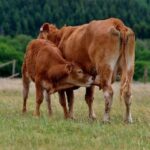Giving birth to calves is a natural part of a cow’s life like any other animal. This process is also essential for them to produce milk, just like mammals.
It is interesting to note that cows generally give birth to one calf at a time, either a female (heifer) or male (bull) calf. However, with the advancement in technologies and increasing demand for milk and meat.
So, it is interesting to explore the birthing capacity of a cow and facts related to it. In the following article, therefore, we will focus on the same topic and analyze some of the most exciting FAQs.

What is the first age that a cow can reproduce?
The most economic trait of a cow is its ability to breed and milk. These two traits are running the contemporary dairy businesses.
A cow is prepared to conceive its first baby around the age of 15 to 24 months. This age should always be less than 36 months. In some cases, beef cows can conceive their first calf below the age of 1 year. This is called precocious puberty, and it may cause a complicated pregnancy due to an underdeveloped birth canal.
How many calves does a cow have at once?
Cattle, like many other livestock animals, have the ability to give multiple births.
However, as per the thumb rule, a cow should have one calve at once. Therefore, the controlled breeding process can prove beneficial for the overall health status of a cow.
How many calves can a cow have in one pregnancy?
Learning about cows’ calf-producing capacity is essential. This is so because it enables the breeders and farm owners to prepare themselves to welcome the new baby and create a suitable environment for it to survive.
Cows can give birth to more than one calf in one pregnancy. However, if we follow the general trend, we will see that beef cows give birth to one calf for each pregnancy.
How many calves can a cow have in her lifetime?
In the US, as per the general trend, a cow can first give birth at 2 years. Also, in commercial settings, their average life span runs somewhere between 5 and 7 years.
If we do the maths, we would find that a cow can give birth to 4 to 6 calves in its lifetime. However, in a natural setting, a cow can have a 15- 20 years lifespan, and it can calve till 9 or 10 years of age. So, we can expect it to give birth to 7- 10 calves in its lifetime in such circumstances.
Here, however, we must keep in mind that the calving capacity of cows tends to be dependent on several factors, like:
- Health status
- Phycological condition
- Environmental impacts. Etc.
How many days does a cow’s pregnancy continue?
The gestation period of different mammals varies based on their species, gender, and other factors. Investigations about the gestation period in cattle have been carried for over a century.
As per most empirical studies and farm owners, the average gestation period of most cows is somewhere between 280 and 285 days. However, 283 days (9 months 10 days) would be typical for most breeds of cows. Cows with bull calves have a somewhat longer pregnancy time than cows with heifer calves.
Knowing cows’ gestation period can be of great help for farm owners and cow breeders. We say so because they can have an idea of the time to expect the calf’s birth, enabling them to prepare the suitable condition for the cow to give birth.
How long after giving birth can a cow become pregnant again?
Most of us have seen cows pregnant almost all the time of their life. So, it often wonders us as to how frequently can they calve? Let us explore!
After giving birth, it is commonly assumed that a cow’s reproductive tract needs at least 30 days of rest to restore to normal. So, if everything else remains good, you can expect a cow to conceive again within 45-60 days after calving.
However, this period can be dependent on different factors, including the cow’s
- Overall health condition
- Age
- Physical condition during calving
- Issues at the time of calving
- Diet
- Baby blues, etc.
Here another thing to notice is that cows after their first calving have a longer post-partum gap than more matured cows.
How many times a year can a cow give birth?
What is the gestation period of a cow? It is usually 283 days, and there remains a gap of 30 days before the cow gets pregnant again.
Going by the above calculation, if a cow rebreeds soon after getting back to normal health, post-calving, she could give birth at least twice a year. However, if good cattle management is followed, breeders should wait to rebreed a cow until their calves are older.
After everything else is stated, rebreeding a cow after calving is considered a reasonable interval period.
How many years can cows have calves?
The calving capacity and productive lifespan of cows are essential for most breeders and cow owners.
According to current data, cows can have a steady rebreeding capacity until they are roughly 8 years old. After that, a fall in this consistency can be observed among cows 10 years of age or older.
Do cows ever have triplets?

As we have mentioned above, the general trend is that a cow gives birth to one calf at a time. However, the probability of twins and/or triplets cannot be ruled out.
Producing twin calves is not uncommon in cows, but having triplets is undeniably rare. But it is not impossible! Not only triplets, but some word records also have cows giving (natural) birth to 5- 6 calves at once.
That being said, multiple births among cows are a rare condition. And a cow’s likelihood to have twins stands somewhere between 1- 7 %. Nonetheless, the incidents of calving triplets are more commonly found among the Holstein-Friesian breeds.
Conclusion
To conclude, we can state that, like other mammals, cows need to reproduce to lactate, and they have a natural reproductive cycle and life. But to compensate for the need of the growing dairy and meat market, they have to undergo several unnatural processes to increase their reproductive capacity.
Leaving the ethical debate aside, we want to state that to maintain a healthy life status of cows, every breeder and cow owner should follow the basic steps towards caring for their cows. This will keep up the cows’ calving capacity and ensure a better and longer reproductive lifespan.





